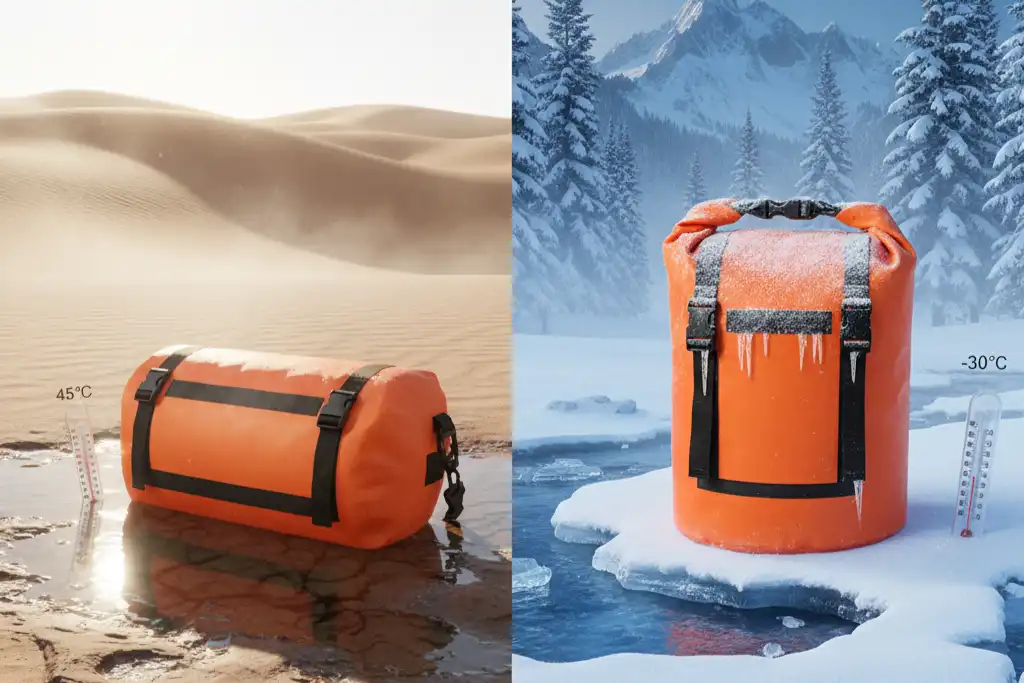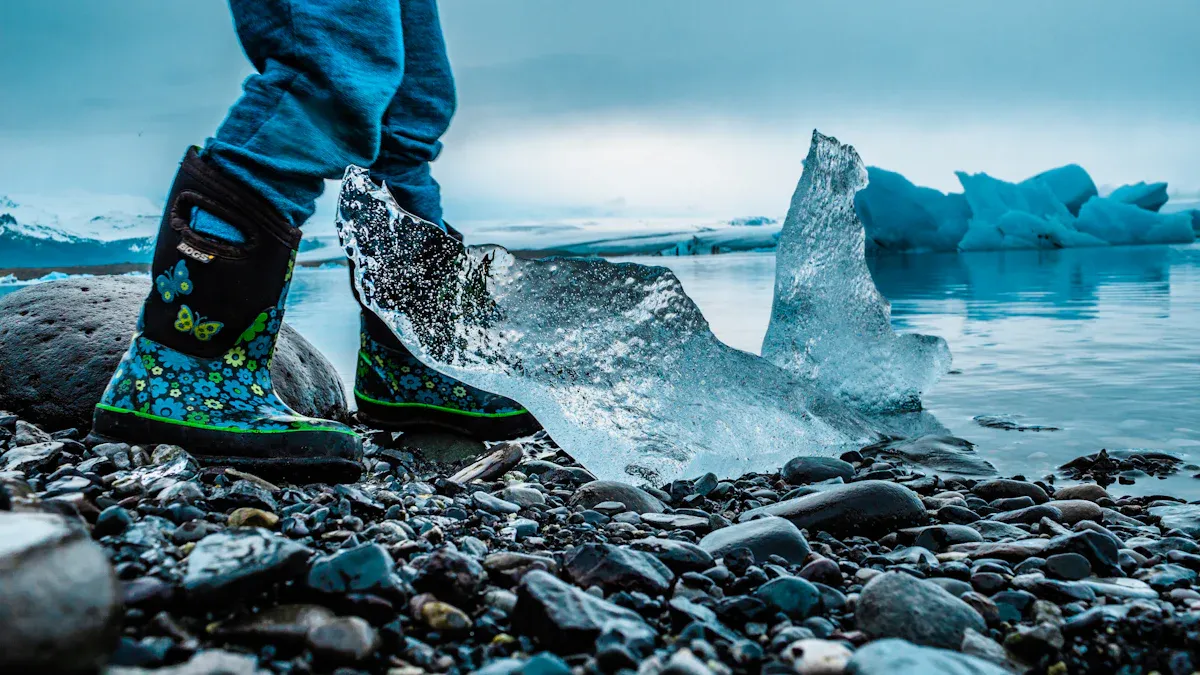Do Waterproof Bags Lose Effectiveness in Hot or Cold Weather

Imagine you are hiking in very hot weather or camping in cold winter. You trust your waterproof bag to protect your things. Very hot or cold weather can change how well your bag works. New designs help bags stay strong and reliable.
- Tests in labs show dry bags work well in heat. The seals stay tight, and thick materials do not break.
- Some people believe these bags always keep things dry. But even the best bags can have problems in tough weather.
Think about how your gear will handle the weather on your next trip.
Key Takeaways
- Pick waterproof bags made from TPU for better use in hot or cold weather. TPU stays bendy, but PVC can break or get stiff.
- Check seals and zippers often for damage. Clean them a lot to keep them tight and stop water from getting in.
- Put your waterproof bag away the right way to help it last longer. Use dust bags that let air in and keep it out of the sun to stop harm.
- Dry your bag well after you use it to stop mold. Add new waterproof coatings often so it keeps working.
- Look at your bag before each trip. Check for cracks or if it feels stiff, and test for leaks to make sure your things stay safe.
Waterproof bag performance in heat
Material changes in high temperatures
When it gets hot, the bag’s material can change. Most waterproof bags are made from plastics like PVC or TPU. These plastics act differently when it gets really warm.
Here is a table that shows what happens to these materials above 90°F:
| Material | Temperature Range | Behavior Above 90°F |
|---|---|---|
| TPU | -50°C to 120°C | Stays bendy |
| PVC | Softens above 60°C | Gets hard and cracks |
TPU keeps its bendy feel, even when it is very hot. PVC can get soft and then crack if it gets too warm. This means a waterproof bag made with PVC might not keep your things safe in the heat. PVC also breaks down faster in sunlight and heat. TPU bags last longer and keep their shape better.
- TPU stays bendy in hot and cold.
- PVC cracks if it gets hotter than 140°F.
- PVC breaks more easily than TPU in the sun and heat.
If you want to use your waterproof bag in a hot place, check what it is made of. TPU is a better choice and lasts longer.
Seal and zipper concerns
Heat does not just change the bag’s main material. Seals and zippers can also get weaker when it is hot. You need to watch these parts because they keep water out.
Waterproof zippers make a tight seal. When it is hot, the material around the zipper can stretch. This stretching can make small gaps and let water in. Check your zippers often and keep them clean. Taking care of them helps keep water out.
Here is a table that shows where seals and zippers can fail in hot weather:
| Failure Point | Description |
|---|---|
| Main case opening | Water can sneak in around the main opening, even with an O-ring. |
| Sharp bends in sealing mechanisms | Corners where the gasket or O-ring bends are weak spots. |
| Pressure on sealing surfaces | Too much pressure can break the seal and let water in. |
Waterproof bags can also trap air and water inside. This can cause wetness inside the bag, especially when it is hot. Electronics or clothes can get damp from the air, even if water does not leak in.
Tip: Try to open your waterproof bag in a cool, dry place. This helps stop wetness from building up inside.
If you use your waterproof bag in hot weather, check the seals and zippers before every trip. Make sure they close tight and do not look worn out. Doing this helps keep your things safe.
Waterproof bag issues in cold

Brittleness and cracking
Cold weather can make your waterproof bag stiff. When it gets cold, the bag’s material is not flexible. You might see that the bag does not bend well. If you fold or squeeze it, it might crease or crack. Some materials have this problem more than others.
Here is a table that shows how different materials act in the cold:
| Material Type | Flexibility in Cold Weather | Susceptibility to Cracking |
|---|---|---|
| PVC (Polyvinyl Chloride) | Less flexible | Can crease or crack |
| TPU (Thermoplastic Polyurethane) | Remains pliable | Less prone to cracking |
| Coated Nylon | Lower durability | More susceptible to punctures |
PVC bags get stiff and can crack in freezing weather. TPU bags stay soft and bendy, so they do not break as much. Coated nylon bags can get holes or tears if you drop them or scrape them on ice. If you want to use your waterproof bag in the cold, pick one made with TPU. It will protect your things better.
Tip: Always check your bag for cracks or stiff spots before packing for a winter trip. Small cracks can get bigger and let water in.
Seal shrinkage
Seals keep water out of your bag. In cold weather, seals can shrink and lose stretch. Rubber and other elastomeric materials get less stretchy when cold. This makes it harder for the seal to close tight. If the seal cannot bounce back after you open or close the bag, water can leak inside.
Here is a table that explains what happens to seals in cold weather:
| Effect of Cold Temperature on Elastomeric Materials | Description |
|---|---|
| Loss of Elasticity | Cold weather can make rubber lose stretch, so it cannot go back to its normal size after being squeezed. |
| Increased Brittleness | Being in the cold for a long time can make elastomeric materials brittle, which can cause leaks. |
| Compression Set | More of the material does not go back to its normal size in the cold, so the seal can fail. |
When seals get stiff, they cannot press tight against the bag’s opening. This can make tiny gaps. Water can sneak in through these gaps, even if the bag looks closed. At very low temperatures, seals might whistle or leak, showing they do not work well.
Note: If you use your waterproof bag in freezing weather, open and close the seals gently. Do not force them. Let the bag warm up inside before you check for leaks.
You can protect your things by picking bags with seals made for cold weather. Look for bags that say they work in very cold places. You will get better results and keep your stuff dry.
Protecting your waterproof bag
Material selection
You want your waterproof bag to last in any climate. Choose materials that resist temperature changes. TPU works well in both hot and cold weather. PVC can crack or get brittle faster. Nylon blends offer good strength but may delaminate over time. Here is a table that shows how long each material usually lasts and what can go wrong:
| Material | Expected Lifespan (years) | Main Failure Mode |
|---|---|---|
| TPU | 5–7 | UV degradation |
| PVC | 3–5 | Brittleness, cracking |
| Nylon+TPU | 4–6 | Delamination |
| Nylon+PVC | 3–4 | Seam tape delamination |
Pick a bag with TPU or a nylon+TPU blend for better durability in extreme temperatures.
Storage tips
Proper storage helps your bag stay strong. You can follow these tips:
- Use breathable dust bags instead of plastic zip cases. This stops moisture from building up.
- Stuff your bag with acid-free tissue paper. This keeps its shape and prevents creases.
- Place silica gel packets or moisture absorbers in humid areas.
- Keep your bag away from direct sunlight and vents.
Tip: Store your bag in a dry, ventilated place to prevent mold and damage.
Extra precautions
You can extend the life of your waterproof bag with regular care. Outdoor experts recommend these steps:
- Clean your bag with mild soap and lukewarm water. Focus on zippers and seams.
- Choose a waterproofing product that fits your bag’s material.
- Treat seams and zippers with sealers or lubricants.
- Let your bag dry in a ventilated area for 24 hours after waterproofing.
You should rinse your bag after use, especially if you use it in saltwater or mud. Air dry it away from sunlight. Check seams and closures for wear and test for leaks often. Reapply waterproof treatments every few months if you travel a lot.
Note: Using liners or double-bagging adds extra protection for your gear in tough weather.
Extreme temperatures can change how your waterproof bag works. You can keep your gear safe by choosing strong materials and caring for your bag. Experts suggest these steps:
- Dry your bag after each use to stop mold.
- Clean it often to protect waterproof coatings.
- Refresh waterproof sprays every year.
- Check and fix worn spots.
- Pack smart and secure rain covers.
Check your waterproof bag before your next trip. Good care helps your bag last longer and keeps your things dry.
FAQ
Can waterproof bags freeze in cold weather?
Yes, waterproof bags can freeze if you leave them outside in very low temperatures. Frozen bags may crack or lose flexibility. You should store your bag indoors when possible.
Do waterproof bags protect electronics in extreme heat?
Waterproof bags keep water out, but heat can damage electronics inside. You should avoid leaving your bag in direct sunlight. Use extra padding or insulation for sensitive devices.
How often should you check seals and zippers?
You should check seals and zippers before every trip. Look for cracks, gaps, or stiffness. Clean and lubricate zippers regularly to keep them working well.
What is the best material for all-weather waterproof bags?
TPU works best for hot and cold weather. It stays flexible and strong. PVC may crack or get brittle. Nylon blends offer good strength but may wear out faster.
See also
How to Choose the Appropriate Zipper and Buckle for Outdoor Backpacks
How to Determine the Right Size Zipper



Comments are closed